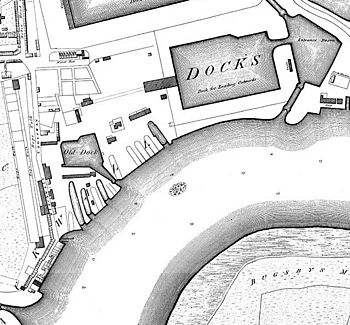Blackwall Rock facts for kids

The rock depicted on Richard Horwood's 1790s map of London
|
|
| Geography | |
|---|---|
| Location | Blackwall, River Thames |
| Coordinates | 51°30′23″N 0°0′07.1″W / 51.50639°N 0.001972°W |
| OS grid reference | TQ385802 |
| Area | 4,181 m2 (45,000 sq ft) |
The Blackwall Rock was a large, rocky obstacle, like an underwater mountain, in the River Thames in East London. This rock was a good place for ships to anchor safely. However, it was also very dangerous for boats trying to sail through the river. The rock was removed in the early 1800s after the nearby West India Docks opened.
What Was Blackwall Rock?
Blackwall Rock was located near Blackwall Stairs, which was the end of a path from Poplar High Street. This path crossed a large area of marshland between the entrances of the West and East India Docks.
The rock was always a danger to river traffic. At low tide, it was sometimes less than 1 meter (3 feet) below the water's surface. This meant ships could easily hit it. When the West India Docks opened in 1802, the rock made it very hard for ships to enter the docks safely.
In 1803, a man named Robert Edington wrote about the rock. He said he had measured it and found it was much bigger than people thought. Before his survey, many believed the rock was about 12 meters (40 feet) by 9 meters (30 feet). However, Edington's measurements showed it was closer to 180 meters (600 feet) long and 45 meters (150 feet) wide.
Edington believed the rock was not a "natural stone." He thought it was made of a strong, iron-like material that had formed over time from particles in the river. He also mentioned a story that the rock was first found in the early 1700s when a large ship, called an Indiaman, crashed into it. Most other records say the rock was about 90 meters (300 feet) by 45 meters (150 feet). An 1846 report described it as a type of rock called "plum-pudding stone."
Removing the Dangerous Rock
The opening of the West India Docks in 1802 and the East India Docks in 1803 made it necessary to remove Blackwall Rock. It was simply too dangerous and blocked the way for ships entering the new docks.
Robert Edington suggested using prison labour to remove the rock. He thought that 200 convicts could be placed on a ship near the rock. They would use special tools to drill holes and blast the rock with explosives. He also suggested using a large iron box, called a caisson, to create a dry area for workers. This would allow them to place explosives deep inside the rock. He knew this method could be dangerous for the workers.
Early attempts to break the rock with explosives did not work very well. So, Trinity House, a group responsible for safe navigation, hired William Jessop to oversee the removal. He worked with other engineers, including Ralph Walker and James Spedding. It's also possible that Richard Trevithick, a famous inventor, worked on the project at some point.
Jessop's team used a large chisel, operated from a barge, similar to how pile driving works (driving poles into the ground). This method successfully lowered the rock's height by about 4.5 meters (15 feet). After that, they used a cylindrical coffer dam (which was also like a diving bell) to allow workers to go down and remove the broken pieces of rock.
The work to remove Blackwall Rock lasted from 1804 to 1808. After the rock was gone, nearby sandy areas in the river also disappeared. By 1847, maps and sailing guides for the River Thames no longer mentioned any danger from a rock in that area.

